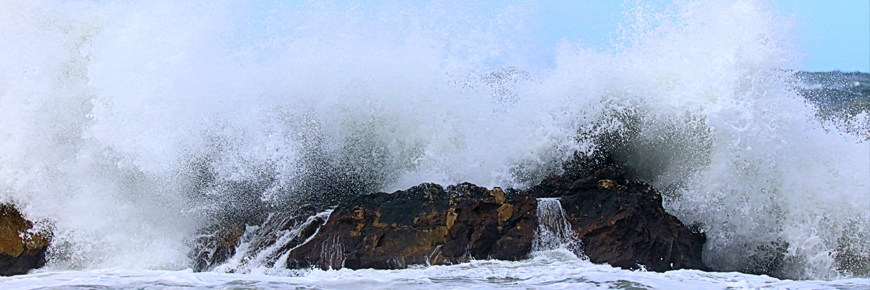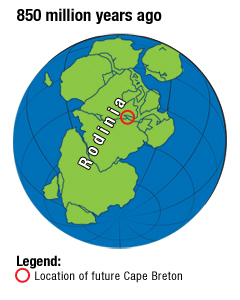
The formation of Cape Breton Island
Cape Breton Highlands National Park

A map of current-day Cape Breton showing the location of the Blair River Complex, Bras D'Or and Avalon Terranes.
To understand the geology of Cape Breton Island, we must first look at how the geological landscapes (terranes) that form the island today came together. Plate tectonics - the movement and collision of continents - has played a major role in forming the island of Cape Breton.
Three terranes make up Cape Breton Island. The Blair River inlier on the northwest tip is composed of the oldest rocks known in the Maritime Provinces. The Bras d'Or terrane which makes up most of the northern half of Cape Breton Island is a series of sedimentary and volcanic rocks that began forming off the northwest coast of the continent we now call South America. The Avalon terrane which makes up the southern half of Cape Breton Island is volcanic rock that first began forming on the northwest coast of what is now Africa.

1,500 to 750 million years ago - a violent beginning
The oldest rocks in the Maritime Provinces form the Blair River inlier which is found in the northwestern corner of Cape Breton Island. They can be seen on North Mountain as you drive up from Pleasant Bay. These rocks were formed 1,500 to 1,000 million years ago during the collision of continental plates that resulted in the supercontinent Rodinia. They are probably a continuation of the Canadian Shield which is found in parts of Labrador, Québec, Ontario and Nunavut. As such, they are likely part of the core of the North American continent.
750 to 450 million years ago - Rodinia breaks up, new land is created
Rodinia broke up into smaller continents which geologists call Laurentia (LA), Amazonia (AM), Protogondwana (PG) and Baltica (BA). These continents were separated by growing oceans. The Brazilide Ocean, found between Amazonia and Protogondwana, was the earliest to form. About 150 million years later, the Iapetus Ocean began to open up between Laurentia and Amazonia.
As the early continents migrated, island arcs formed off the coast of Protogondwana, giving rise to the volcanic rocks of the Avalon terrane. Sedimentary rocks laid down in the seas off Amazonia which were later intruded with igneous rocks formed the Bras d'Or terrane.
The Bras d'Or terrane and the Avalon terrane were driven together as the Brazilide Ocean closed about 580 to 450 million years ago to form Gondwana.
450 to 360 million years ago - Cape Breton Island assembled
Through this time period, continents collided again. Baltica bumped into Laurentia to form a new continent called Euramerica. The Bras d'Or and Avalon terranes were dragged along by Baltica to became part of Euramerica too. The Blair River inlier, formed a billion years earlier and lying on the edge of the Laurentian Plate, was finally sandwiched together with these other two terranes to form the core of what we now know as Cape Breton Island.
Related links
- Date modified :